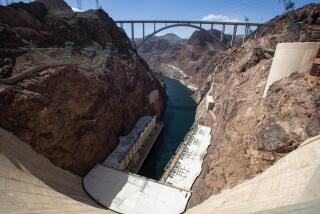SAN DIEGO COUNTY PERSPECTIVE : Shoring Up Our Water Consciousness
- Share via
In some ways, today’s San Diego County Water Authority meeting will be a tougher test of water discipline than the one on March 14, when stringent rationing rules were adopted to produce 50% cutbacks.
At that time, the county’s water wholesaler, the Metropolitan Water District, had already announced that it would cut water deliveries in half throughout Southern California. So San Diego had little choice but to establish strict mandatory rules to make sure everyone had enough water for essential needs.
Those rules were postponed due to rain, and today, when the Water Authority board reconsiders them, it has a little wiggle room. Because of the heavy rain and snow last month, MWD will only be cutting water deliveries 31% instead of 50%.
There are sure to be plenty of suggestions on how to divvy up the “extra” water, including the idea of staying with a voluntary plan. But abandoning mandatory rules would send the wrong signal to consumers. The board must send a clear message that the drought is not over. And it should provide consumers with rules on how to get 31% conservation on an ongoing basis.
The city of San Diego has had a remarkable conservation rate of 37.7% since March 1 under Mayor Maureen O’Connor’s defiantly voluntary plan. That makes voluntary conservation tempting.
But can such cutbacks be maintained by goodwill alone when the sun starts baking the lush green out of the grass and 50 gallons a day out of back-yard pools?
The unanticipated water supplied by nature can keep the summer a little greener, a little safer from fire, less economically parched and more enjoyable. But it should not be allowed to erode San Diego’s belated water consciousness.
If there is enough water to allow more flexibility in how consumers meet the 31% reduction, great. If limited irrigation of grass and trees can be allowed, all the better. But restricting watering to the most efficient hours and limiting how often landscaping can be watered should not be eliminated. Neither should curbs on runoff or hosing paved areas.
Those rules just make common sense in an area that can only supply 5% of its own water needs. So do rebates for low-volume toilets and low-flow shower heads and faucets.
But perhaps the most important concept to preserve is the link between new water hookups and offsetting conservation measures. This drought has shown how important it is that San Diego County not grow beyond its water means. When new housing projects are permitted, builders should have to ensure that a substantial portion of the water the new residents are expected to consume will be saved elsewhere.
Too often in the past, the Water Authority and other officials have let consumers off the hook. “Don’t Be A Waterhog” admonitions came out of one side of their mouths, while assurances of ample water supply came out the other.
Today, the Water Authority has the opportunity to establish a realistic water ethic that can help San Diego through the present drought--and be less vulnerable to future ones.
More to Read
Sign up for Essential California
The most important California stories and recommendations in your inbox every morning.
You may occasionally receive promotional content from the Los Angeles Times.













